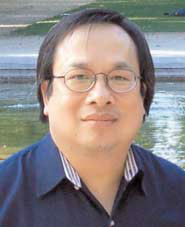How can 20th-century fibre optics handle the connectivity needs of the 21st century? Researchers in the Laboratories for Broadband Optical and Wireless Systems have a few ideas.
By James Martin

Those YouTube videos, iTunes downloads or, for nostalgists, land-line phone calls are all transmitted using the tens of thousands of kilometres of fibre optic cable (in Canada alone) that’s running beneath our feet. The system works well, especially with high data rate fibre (HDF) capable of handling 40 gigabits per second. The problem? Unless your home or office is new, it’s probably full of old cable that falters when asked to handle too much information. The second problem: “Civil works,” techie-speak for replacing old cable with HDF, is a prohibitively expensive proposition. But just because we’re stuck with yesterday’s cable doesn’t mean we can’t have tomorrow’s speed.
“There’s no great secret as to what’s needed: more bandwidth, more connectivity, at a lower cost,” explains electrical and computer engineering professor David Plant. Plant is a member of the Laboratories for Broadband Optical and Wireless Systems (LBOWS), a research partnership between McGill, Queen’s, Laval and Université du Québec’s INRS-Énergie, Matériaux et Télécommunications. He holds an NSERC/Bell Canada Industrial Research Chair. “The fibres that were installed five or ten years ago were originally designed to handle 10 gigabits per second, and now they’re being asked to do 40 gigabits and, soon, 100 gigabits. The research challenge is to run high data rates through a channel that was never designed to go that fast—so we’re working on new ways to send the light into the fibre optic cable, amplify it, manage the impairments, and receive the light at the other end.”
Using traditional on/off keying, each light element (that is, the absence or presence of light) represents one bit of information. At its base level, all that video and audio information is nothing more than binary code: long strings of zeros and ones. With on/off keying, each digit is coded into light: a laser is turned on to represent a one, and turned off for zero. That light is then sent across vast distances through glass fibres, then the binary code is reconstructed. Plant, along with McGill professors Lawrence Chen and Martin Rochette and their LBOWS colleagues, however, are exploring the benefits of “spectral efficiency,” namely modulating the phase characteristics of that single light burst so it can convey more than one bit of information. Instead of all bursts being the same, there are potentially infinite distinct “shadings.” A full-tone light burst, for example, could be deemed the visual equivalent of the four-bit sequence 0000. A three-quarter tone light could represent 0001, and a half-tone light represent 0011. Suddenly four bits of information, not merely one, are travelling in that single burst of modulated light—quadrupling the amount of information the fibre is conveying, but without changing the fibre itself.

Spectral efficiency has long been a concern of wireless researchers because the wireless medium is especially prone to data loss; a radio signal from a wireless modem, for example, has to bounce around a room—even through walls—before it establishes a connection with a laptop computer. “It’s much easier to transmit one gigabit per second in fibre than it is in wireless,” explains LBOWS researcher Tho Le-Ngoc, professor in McGill’s Department of Electrical and Computer Engineering. Le-Ngoc is also the Canada Research Chair in Broadband Access Communications and an NSERC/Bell Canada Industrial Research Chair. “With today’s technology, fibre can easily transmit 100 gigabits per second of information, but wireless can only do 100 megabits per second. By the year 2015, we hope wireless can do one gigabit per second, or 10 times the current data rate—that’s how far behind wireless is.” To help wireless communication get up to speed (literally), Le-Ngoc and McGill professors Harry Leib, Ioannis Psaromiligkos, Benoît Champagne and Jan Bajcsy are exploring multi-dimensional transmission. The simplest form of wireless transmission is a signal travelling from one antenna to another. Their research includes MIMO (multiple input, multiple output) systems, which amounts to using a group of antennas working in concert to receive and transmit information; the upside is that information can be focused to travel in a specified direction, rather than the current scattershot approach that broadcasts information in all directions with equal intensity. “By better using the space dimension to directionally encode and transmit information,” says Le-Ngoc, “communication will become more effective.”
“The impact of our research can be felt in our ability to look at new ideas and de-risk them,” adds Plant. “This is very applied research. There’s a delicate balance to be achieved in terms of being far enough ahead of industry so that what you’re doing is original and innovative, but close enough to industry so that what you’re doing is relevant. Good researchers in fast-moving technology-based sectors, like communications, have to look ahead and look behind—if you get it right, you can have a huge impact on industry and produce academically rich results.”
Funding sources for LBOWS include the Natural Sciences and Engineering Research Council of Canada, the Canada Foundation for Innovation, PROMPT, the Fonds québécois de la recherche sur la nature et les technologies, SYTACom and the Ministère du Développement économique, de l’Innovation et de l’Exportation.
Next: Mission Regeneration
